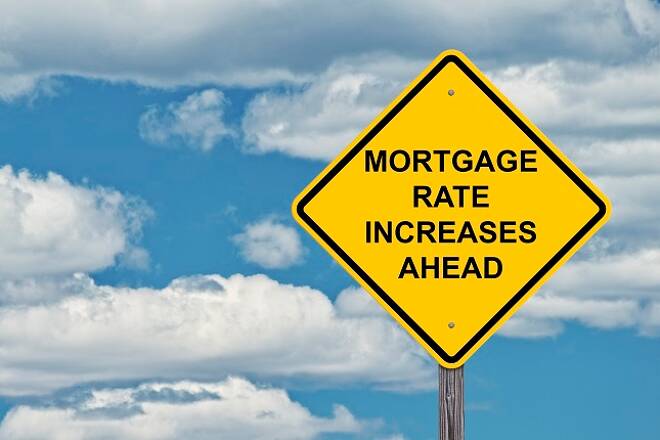Advertisement
Advertisement
U.S Mortgage Rates – Upward Trend Resumes
By:
Mortgage rates were on the rise once more, with rates hitting the 2nd highest of the year, bringing to an end two consecutive weeks of decline, reminding home buyers of the perils of leaving it too long.
Mortgage rates were on the rise again in the week ending 14th June, bringing to an end two consecutive weeks’ of decline, with rates rising to their second highest of the year in response to the FED’s 25 basis point rate hike on Wednesday and a mass of other key drivers including rising prospects of a global trade war.
According to Freddie Mac, the effects of the FED’s current monetary policy cycle is expected to have lesser impact on home buyers and owners however, with a smaller portion of mortgage loans being pegged to short-term interest rate movements. According to Freddie Mac, the adjustable mortgage rate (ARM) share of outstanding loans is significantly smaller, down from 31% in the last FED rate hike cycle to just 8% in the current one.
While short-term rates may have less of an impact, inflationary pressures have been building and when combined with rising mortgage rates and rising house prices, wage growth is going to need to catch up for the housing sector to continue to see rising house prices driven by an under supply – over-demand dynamic.
Freddie Mac weekly average rates for new mortgages as of 14th June were quoted to be:
- 30-year fixed rate loan increased from 4.54% to 4.62% in the week, while up from 3.91% a year ago.
- 15-year fixed rates rose from 4.01% to 4.07% last week, while up from 3.18% from a year ago.
- 5-year fixed rates jumped from 3.74% to 3.83% over the week, while up from last year’s 3.15%.
Mortgage Bankers’ Association Rates for the week ending 13th June were quoted to be:
- Average interest rates for 30-year fixed, backed by the FHA increased from 4.77% to 4.83%.
- Average interest rate for 30-year fixed with conforming loan balances rose from 4.75% to 4.83%.
- Average 30-year rates for jumbo loan balances increased from 4.70% to 4.74%.
Weekly figures released by the Mortgage Bankers’ Association showed that the Market Composite Index, which is a measure of mortgage loan application volume, fell by 1.5%, following the previous week’s 4.1% rise week-on-week. The fall coming in spite of a second consecutive week of falling rates to the week ending 8th June.
The Refinance Index also fell, down 2% in the week ending 8th June, partially reversing the previous week’s 4% rise, with the refinance share of mortgages remaining unchanged at 35.6%, the recent downward trend in refinance rates resuming.
The Mortgage Bankers’ Association also released its first quarter mortgage delinquency report on Thursday, with delinquency rates for commercial and multifamily mortgage loans remaining relatively flat through the 1st quarter, sitting at or close to all-time lows, supported by the relatively low mortgage rate environment, a positive economic outlook, rising house prices and an ever tightening labour market conditions.
Based on unpaid principal balance (UPB) of loans, delinquency rates for the quarter ending 31st March 2018 were as follows:
- Banks and thrifts (90 or more days delinquent or in non-accrual): 0.51%, unchanged from the quarter ending 31st December 2017.
- Life company portfolios (60 or more days delinquent): 0.02%, down 0.01 percentage points from the quarter ending 31st December 2017.
- Fannie Mae (60 or more days delinquent): 0.13%, a 0.02 percentage point increase from the quarter ending 31st December 2017.
- Freddie Mac (60 or more days delinquent): 0.02%, unchanged from the 4th quarter of last year.
- CMBS (30 or more days delinquent or in REO): 3.93%, a 0.15 percentage point fall from the 4th quarter of last year.
While mortgage credit remained widely readily available, supported by the current economic environment and labour market conditions and low delinquency rates, supply continues to be an issue with new home sales reaching the lowest level since December 2017 in May according the MBA, with unadjusted figures showing a 4.8% fall in May, month-on-month. Year-on-year, new home sales were estimated to have fallen by more than 5%.
For the week ahead, stats out of the U.S are on the quieter side, with key economic data including new home sales, existing home sales and building permits and housing starts figures for May, which will provide further insight into the current supply-demand imbalance that has continued to favour home owners.
While other stats through the week include prelim June private sector PMI numbers, the Philly FED Manufacturing PMI for July and the weekly jobless claims figures, FOMC member chatter through the week will likely be of greater influence alongside noise from the Oval Office.
FOMC Members Dudley, Duke, Bostic, Williams, Bullard are all scheduled to speak in the week, ahead of FED Chair Powell’s speech on Wednesday, the FED having pencilled in an additional rate hike to make it a projected 2 hikes through the 2nd half of the year.
With FOMC members likely to be sharing their outlook on policy for the remainder of the year, trade wars are also likely to take centre stage for the financial markets, with any retaliation by China and / or the EU likely to see U.S Treasury yields spike, which would provide further upward pressure to mortgage rates in the week ahead.
About the Author
Bob Masonauthor
With over 20 years of experience in the finance industry, Bob has been managing regional teams across Europe and Asia and focusing on analytics across both corporate and financial institutions. Currently he is covering developments relating to the financial markets, including currencies, commodities, alternative asset classes, and global equities.
Did you find this article useful?
Latest news and analysis
Advertisement
